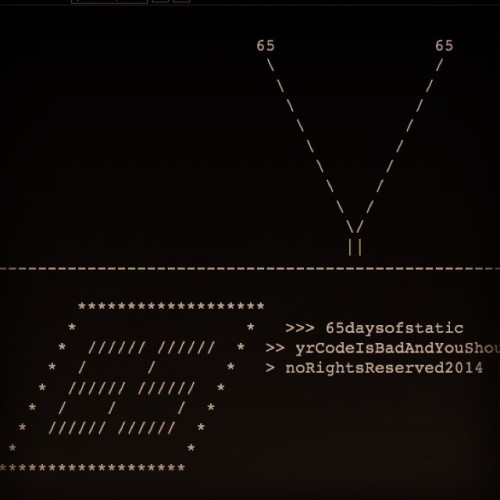


Island cottages on Megunticook Lake, ME.
Photographs by perennial favorite A. William Frederick




"Tubakuba" cabin built by students at the Bergen School of Architecture in Bergen, Norway.
The building process is documented here.
Anton Paisov<3 <3 <3 <3
OSCILLATOR is a collection of off-cuts and lost edits; late night smartphone videos and unused music; real-time noise experiments using diegetic audio on a long stretch of European motorway; code-based sound generators and unmapped kinect territories, as well as footage from the dead cities and exceptional states of 2013’s 'Sleepwalk City' A/V installation.
Wild Light is available digitally here: itunes.apple.com/gb/album/wild-light/id690684580
and physically here: omerch.eu/shop/65daysofstatic/products.php?cat=2188
Find us here: twitter.com/65dos | facebook.com/65propaganda
For everything else: 65daysofstatic.com.
Cast: 65daysofstatic
Tags: 65daysofstatic, oscillator, wild light, noise, drone, glitch, studio, tour, generative audio, processing, noise noise noise, dronenotdrones, sleepwalk city and a/v
Oh little one, you’re growing up
You’ll soon be writing C
You’ll treat your ints as pointers
You’ll nest the ternary
You’ll cut and paste from github
And try cryptography
But even in your darkest hour
Do not use ECB
CBC’s BEASTly when padding’s abused
And CTR’s fine til a nonce is reused
Some say it’s a CRIME to compress then encrypt
Or store keys in the browser (or use javascript)
Diffie Hellman will collapse if hackers choose your g
And RSA is full of traps when e is set to 3
Whiten! Blind! In constant time! Don’t write an RNG!
But failing all, and listen well: Do not use ECB
They’ll say “It’s like a one-time-pad!
The data’s short, it’s not so bad
the keys are long—they’re iron clad
I have a PhD!”
And then you’re front page Hacker News
Your passwords cracked—Adobe Blues.
Don’t leave your penguin showing through,
Do not use ECB
My largest Sidekiq application had a memory leak and I was able to find and fix it in just few hours spent on analyzing Ruby's heap. In this post I'll show my profiling setup.
As you might know Ruby 2.1 introduced a few great changes to ObjectSpace, so now it's much easier to find a line of code that is allocating too many objects. Here is great post explaining how it's working.
I was too lazy to set up some seeding and run it locally, so I checked that test suite passes when profiling is enabled and pushed debugging to production. Production environment also suited me better since my jobs data can't be fully random generated.
So, in order to profile your worker, add this to your Sidekiq configuration:
if ENV["PROFILE"]
require "objspace"
ObjectSpace.trace_object_allocations_start
Sidekiq.logger.info "allocations tracing enabled"
module Sidekiq
module Middleware
module Server
class Profiler
# Number of jobs to process before reporting
JOBS = 100
class << self
mattr_accessor :counter
self.counter = 0
def synchronize(&block)
@lock ||= Mutex.new
@lock.synchronize(&block)
end
end
def call(worker_instance, item, queue)
begin
yield
ensure
self.class.synchronize do
self.class.counter += 1
if self.class.counter % JOBS == 0
Sidekiq.logger.info "reporting allocations after #{self.class.counter} jobs"
GC.start
ObjectSpace.dump_all(output: File.open("heap.json", "w"))
Sidekiq.logger.info "heap saved to heap.json"
end
end
end
end
end
end
end
end
Sidekiq.configure_server do |config|
config.server_middleware do |chain|
chain.add Sidekiq::Middleware::Server::Profiler
end
end
end
Adjust number of jobs you want your worker to process before you have heap dumped.
Run a sample worker: PROFILE=1 sidekiq -C config/sidekiq.yml and wait for jobs to be processed.
After you have heap.json, analyze it by running something like this:
cat heap.json |
ruby -rjson -ne ' obj = JSON.parse($_).values_at("file","line","type"); puts obj.join(":") if obj.first ' |
sort |
uniq -c |
sort -n |
tail -20
You'll see a list of objects of specific types that are allocated on specific lines, sorted by objects count, for example:
460 /home/whatever/.rvm/gems/ruby-2.1.0/bundler/gems/mongoid-3.1.6/lib/mongoid/dirty.rb:368:DATA
460 /home/whatever/.rvm/gems/ruby-2.1.0/bundler/gems/mongoid-3.1.6/lib/mongoid/fields.rb:388:DATA
460 /home/whatever/.rvm/gems/ruby-2.1.0/bundler/gems/mongoid-3.1.6/lib/mongoid/fields.rb:414:DATA
460 /home/whatever/.rvm/gems/ruby-2.1.0/bundler/gems/mongoid-3.1.6/lib/mongoid/fields.rb:436:DATA
460 /home/whatever/.rvm/gems/ruby-2.1.0/bundler/gems/mongoid-3.1.6/lib/mongoid/fields.rb:456:DATA
472 /home/whatever/.rvm/gems/ruby-2.1.0/gems/activesupport-3.2.16/lib/active_support/concern.rb:115:ICLASS
527 /home/whatever/.rvm/gems/ruby-2.1.0/gems/activesupport-3.2.16/lib/active_support/dependencies.rb:469:NODE
529 /home/whatever/.rvm/gems/ruby-2.1.0/gems/activesupport-3.2.16/lib/active_support/core_ext/class/attribute.rb:79:NODE
573 /home/whatever/.rvm/gems/ruby-2.1.0/gems/activesupport-3.2.16/lib/active_support/core_ext/array/wrap.rb:41:ARRAY
606 /home/whatever/.rvm/gems/ruby-2.1.0/gems/activesupport-3.2.16/lib/active_support/dependencies.rb:469:ARRAY
724 /home/whatever/.rvm/gems/ruby-2.1.0/gems/activesupport-3.2.16/lib/active_support/concern.rb:114:ICLASS
844 /home/whatever/.rvm/gems/ruby-2.1.0/gems/journey-1.0.4/lib/journey/parser.rb:139:OBJECT
861 /home/whatever/.rvm/gems/ruby-2.1.0/gems/activesupport-3.2.16/lib/active_support/dependencies.rb:469:DATA
1147 /home/whatever/.rvm/gems/ruby-2.1.0/gems/activesupport-3.2.16/lib/active_support/dependencies.rb:469:STRING
1165 /home/whatever/.rvm/gems/ruby-2.1.0/bundler/gems/mongoid-3.1.6/lib/mongoid/extensions/module.rb:22:STRING
1242 /home/whatever/.rvm/gems/ruby-2.1.0/gems/activesupport-3.2.16/lib/active_support/core_ext/class/attribute.rb:74:ARRAY
1281 /home/whatever/.rvm/gems/ruby-2.1.0/gems/activesupport-3.2.16/lib/active_support/core_ext/class/attribute.rb:81:DATA
2083 /home/whatever/.rvm/gems/ruby-2.1.0/gems/activesupport-3.2.16/lib/active_support/core_ext/class/attribute.rb:74:NODE
2429 /home/whatever/.rvm/gems/ruby-2.1.0/bundler/gems/mongoid-3.1.6/lib/mongoid/extensions/module.rb:22:DATA
3325 /home/whatever/.rvm/gems/ruby-2.1.0/gems/activesupport-3.2.16/lib/active_support/core_ext/class/attribute.rb:74:DATA
Repeat this action after more jobs are processed. If you see a constantly growing objects count somewhere, this is probably your leak.
Like everyone, appearing smart during meetings is my top priority. Sometimes this can be difficult if you start daydreaming about your next vacation, your next nap, or bacon. When this happens, it’s good to have some fallback tricks to fall back on. Here are my ten favorite tricks for quickly appearing smart during meetings.

Getting up and drawing a Venn diagram is a great way to appear smart. It doesn’t matter if your Venn diagram is wildly inaccurate, in fact, the more inaccurate the better. Even before you’ve put that marker down, your colleagues will begin fighting about what exactly the labels should be and how big the circles should be, etc. At this point, you can slink back to your chair and go back to playing Candy Crush on your phone.
If someone says “About 25% of all users click on this button,” quickly chime in with, “So about 1 in 4,” and make a note of it. Everyone will nod their head in agreement, secretly impressed and envious of your quick math skills.
There comes a point in most meetings where everyone is chiming in, except you. Opinions and data and milestones are being thrown around and you don’t know your CTA from your OTA. This is a great point to go, “Guys, guys, guys, can we take a step back here?” Everyone will turn their heads toward you, amazed at your ability to silence the fray. Follow it up with a quick, “What problem are we really trying to solve?” and, boom! You’ve bought yourself another hour of looking smart.

Always bring a notepad with you. Your rejection of technology will be revered. Take notes by simply writing down one word from every sentence that you hear. Nod continuously while doing so. If someone asks you if you’re taking notes, quickly say that these are your own personal notes and that someone else should really be keeping a record of the meeting. Bravo compadre. You’ve saved your ass, and you’ve gotten out of doing any extra work. Or any work at all, if you’re truly succeeding.
Make a mental note of the engineer in the room. Remember his name. He’ll be quiet throughout most of the meeting, but when his moment comes everything out of his mouth will spring from a place of unknowable brilliance. After he utters these divine words, chime in with, “Let me just repeat that,” and repeat exactly what he just said, but very, very slowly. Now, his brilliance has been transferred to you. People will look back on the meeting and mistakenly attribute the intelligent statement to you.
It’s important to find out if things will scale no matter what it is you’re discussing. No one even really knows what that means, but it’s a good catch-all question that generally applies and drives engineers nuts.

Whenever someone gets up from the table and walks around, don’t you immediately respect them? I know I do. It takes a lot of guts but once you do it, you immediately appear smart. Fold your arms. Walk around. Go to the corner and lean against the wall. Take a deep, contemplative sigh. Trust me, everyone will be shitting their pants wondering what you’re thinking. If only they knew (bacon).
“Sorry, could you go back a slide?” They’re the seven words no presenter wants to hear. It doesn’t matter where in the presentation you shout this out, it’ll immediately make you look like you’re paying closer attention than everyone else is, because clearly they missed the thing that you’re about to brilliantly point out. Don’t have anything to point out? Just say something like, “I’m not sure what these numbers mean,” and sit back. You’ve bought yourself almost an entire meeting of appearing smart.
You’re probably afraid to step out of the room because you fear people will think you aren’t making the meeting a priority. Interestingly, however, if you step out of a meeting for an “important” phone call, they’ll all realize just how busy and important you are. They’ll say, “Wow, this meeting is important, so if he has something even more important than this, well, we better not bother him.”
If someone asks what you think, and you honestly didn’t hear a single word anyone said for the last hour, just say, “I honestly didn’t hear a single word anyone said for the last hour.” People love self-deprecating humor. Say things like, “Maybe we can just use the lawyers from my divorce,” or “God I wish I was dead.” They’ll laugh, value your honesty, consider contacting H.R., but most importantly, think you’re the smartest person in the room.

A 65 code-based audio test. http://gibber.mat.ucsb.edu/?path=65daysofstatic/publications/yrCodeIsBadAndYouShouldFeelBad

Visualization of Steve Reich, Piano Phase. Alexander Chen.
More:
http://createdigitalmusic.com/2014/06/see-phasing-visualization-steve-reichs-piano-phase/

Personal Space
*I like these “beauty of code” things when they’re visibly about the beauty of the code




























I joined LinkedIn about six years ago at a particularly interesting time. We were just beginning to run up against the limits of our monolithic, centralized database and needed to start the transition to a portfolio of specialized distributed systems. This has been an interesting experience: we built, deployed, and run to this day a distributed graph database, a distributed search backend, a Hadoop installation, and a first and second generation key-value store.
One of the most useful things I learned in all this was that many of the things we were building had a very simple concept at their heart: the log. Sometimes called write-ahead logs or commit logs or transaction logs, logs have been around almost as long as computers and are at the heart of many distributed data systems and real-time application architectures.
You can't fully understand databases, NoSQL stores, key value stores, replication, paxos, hadoop, version control, or almost any software system without understanding logs; and yet, most software engineers are not familiar with them. I'd like to change that. In this post, I'll walk you through everything you need to know about logs, including what is log and how to use logs for data integration, real time processing, and system building.

Records are appended to the end of the log, and reads proceed left-to-right. Each entry is assigned a unique sequential log entry number.
The ordering of records defines a notion of "time" since entries to the left are defined to be older then entries to the right. The log entry number can be thought of as the "timestamp" of the entry. Describing this ordering as a notion of time seems a bit odd at first, but it has the convenient property that it is decoupled from any particular physical clock. This property will turn out to be essential as we get to distributed systems.
The contents and format of the records aren't important for the purposes of this discussion. Also, we can't just keep adding records to the log as we'll eventually run out of space. I'll come back to this in a bit.
So, a log is not all that different from a file or a table. A file is an array of bytes, a table is an array of records, and a log is really just a kind of table or file where the records are sorted by time.
At this point you might be wondering why it is worth talking about something so simple? How is a append-only sequence of records in any way related to data systems? The answer is that logs have a specific purpose: they record what happened and when. For distributed data systems this is, in many ways, the very heart of the problem.
But before we get too far let me clarify something that is a bit confusing. Every programmer is familiar with another definition of logging—the unstructured error messages or trace info an application might write out to a local file using syslog or log4j. For clarity I will call this "application logging". The application log is a degenerative form of the log concept I am describing. The biggest difference is that text logs are meant to be primarily for humans to read and the "journal" or "data logs" I'm describing are built for programmatic access.
(Actually, if you think about it, the idea of humans reading through logs on individual machines is something of an anachronism. This approach quickly becomes an unmanageable strategy when many services and servers are involved and the purpose of logs quickly becomes as an input to queries and graphs to understand behavior across many machines—something for which english text in files is not nearly as appropriate as the kind structured log described here.)
I don't know where the log concept originated—probably it is one of those things like binary search that is too simple for the inventor to realize it was an invention. It is present as early as IBM's System R. The usage in databases has to do with keeping in sync the variety of data structures and indexes in the presence of crashes. To make this atomic and durable, a database uses a log to write out information about the records they will be modifying, before applying the changes to all the various data structures it maintains. The log is the record of what happened, and each table or index is a projection of this history into some useful data structure or index. Since the log is immediately persisted it is used as the authoritative source in restoring all other persistent structures in the event of a crash.
Over-time the usage of the log grew from an implementation detail of ACID to a method for replicating data between databases. It turns out that the sequence of changes that happened on the database is exactly what is needed to keep a remote replica database in sync. Oracle, MySQL, and PostgreSQL include log shipping protocols to transmit portions of log to replica databases which act as slaves. Oracle has productized the log as a general data subscription mechanism for non-oracle data subscribers with their XStreams and GoldenGate and similar facilities in MySQL and PostgreSQL are key components of many data architectures.
Because of this origin, the concept of a machine readable log has largely been confined to database internals. The use of logs as a mechanism for data subscription seems to have arisen almost by chance. But this very abstraction is ideal for supporting all kinds of messaging, data flow, and real-time data processing.
The two problems a log solves—ordering changes and distributing data—are even more important in distributed data systems. Agreeing upon an ordering for updates (or agreeing to disagree and coping with the side-effects) are among the core design problems for these systems.
The log-centric approach to distributed systems arises from a simple observation that I will call the State Machine Replication Principle:
This may seem a bit obtuse, so let's dive in and understand what it means.
Deterministic means that the processing isn't timing dependent and doesn't let any other "out of band" input influence its results. For example a program whose output is influenced by the particular order of execution of threads or by a call to gettimeofday or some other non-repeatable thing is generally best considered as non-deterministic.
The state of the process is whatever data remains on the machine, either in memory or on disk, at the end of the processing.
The bit about getting the same input in the same order should ring a bell—that is where the log comes in. This is a very intuitive notion: if you feed two deterministic pieces of code the same input log, they will produce the same output.
The application to distributed computing is pretty obvious. You can reduce the problem of making multiple machines all do the same thing to the problem of implementing a distributed consistent log to feed these processes input. The purpose of the log here is to squeeze all the non-determinism out of the input stream to ensure that each replica processing this input stays in sync.
When you understand it, there is nothing complicated or deep about this principle: it more or less amounts to saying "deterministic processing is deterministic". Nonetheless, I think it is one of the more general tools for distributed systems design.
One of the beautiful things about this approach is that the time stamps that index the log now act as the clock for the state of the replicas—you can describe each replica by a single number, the timestamp for the maximum log entry it has processed. This timestamp combined with the log uniquely captures the entire state of the replica.
There are a multitude of ways of applying this principle in systems depending on what is put in the log. For example, we can log the incoming requests to a service, or the state changes the service undergoes in response to request, or the transformation commands it executes. Theoretically, we could even log a series of machine instructions for each replica to execute or the method name and arguments to invoke on each replica. As long as two processes process these inputs in the same way, the processes will remaining consistent across replicas.
Different groups of people seem to describe the uses of logs differently. Database people generally differentiate between physical and logical logging. Physical logging means logging the contents of each row that is changed. Logical logging means logging not the changed rows but the SQL commands that lead to the row changes (the insert, update, and delete statements).
The distributed systems literature commonly distinguishes two broad approaches to processing and replication. The "state machine model" usually refers to an active-active model where we keep a log of the incoming requests and each replica processes each request. A slight modification of this, called the "primary-backup model", is to elect one replica as the leader and allow this leader to process requests in the order they arrive and log out the changes to its state from processing the requests. The other replicas apply in order the state changes the leader makes so that they will be in sync and ready to take over as leader should the leader fail.

To understand the difference between these two approaches, let's look at a toy problem. Consider a replicated "arithmetic service" which maintains a single number as its state (initialized to zero) and applies additions and multiplications to this value. The active-active approach might log out the transformations to apply, say "+1", "*2", etc. Each replica would apply these transformations and hence go through the same set of values. The "active-passive" approach would have a single master execute the transformations and log out the result, say "1", "3", "6", etc. This example also makes it clear why ordering is key for ensuring consistency between replicas: reordering an addition and multiplication will yield a different result.
 The distributed log can be seen as the data structure which models the problem of consensus. A log, after all, represents a series of decisions on the "next" value to append. You have to squint a little to see a log in the Paxos family of algorithms, though log-building is their most common practical application. With Paxos, this is usually done using an extension of the protocol called "multi-paxos", which models the log as a series of consensus problems, one for each slot in the log. The log is much more prominent in other protocols such as ZAB, RAFT, and Viewstamped Replication, which directly model the problem of maintaining a distributed, consistent log.
The distributed log can be seen as the data structure which models the problem of consensus. A log, after all, represents a series of decisions on the "next" value to append. You have to squint a little to see a log in the Paxos family of algorithms, though log-building is their most common practical application. With Paxos, this is usually done using an extension of the protocol called "multi-paxos", which models the log as a series of consensus problems, one for each slot in the log. The log is much more prominent in other protocols such as ZAB, RAFT, and Viewstamped Replication, which directly model the problem of maintaining a distributed, consistent log.
My suspicion is that our view of this is a little bit biased by the path of history, perhaps due to the few decades in which the theory of distributed computing outpaced its practical application. In reality, the consensus problem is a bit too simple. Computer systems rarely need to decide a single value, they almost always handle a sequence of requests. So a log, rather than a simple single-value register, is the more natural abstraction.
Furthermore, the focus on the algorithms obscures the underlying log abstraction systems need. I suspect we will end up focusing more on the log as a commoditized building block irrespective of its implementation in the same way we often talk about a hash table without bothering to get in the details of whether we mean the murmur hash with linear probing or some other variant. The log will become something of a commoditized interface, with many algorithms and implementations competing to provide the best guarantees and optimal performance.
Let's come back to databases for a bit. There is a facinating duality between a log of changes and a table. The log is similar to the list of all credits and debits and bank processes; a table is all the current account balances. If you have a log of changes, you can apply these changes in order to create the table capturing the current state. This table will record the latest state for each key (as of a particular log time). There is a sense in which the log is the more fundamental data structure: in addition to creating the original table you can also transform it to create all kinds of derived tables. (And yes, table can mean keyed data store for the non-relational folks.)

This process works in reverse too: if you have a table taking updates, you can record these changes and publish a "changelog" of all the updates to the state of the table. This changelog is exactly what you need to support near-real-time replicas. So in this sense you can see tables and events as dual: tables support data at rest and logs capture change. The magic of the log is that if it is a complete log of changes, it holds not only the contents of the final version of the table, but also allows recreating all other versions that might have existed. It is, effectively, a sort of backup of every previous state of the table.
This might remind you of source code version control. There is a close relationship between source control and databases. Version control solves a very similar problem to what distributed data systems have to solve—managing distributed, concurrent changes in state. A version control system usually models the sequence of patches, which is in effect a log. You interact directly with a checked out "snapshot" of the current code which is analogous to the table. You will note that in version control systems, as in other distributed stateful systems, replication happens via the log: when you update, you pull down just the patches and apply them to your current snapshot.
Some people have seen some of these ideas recently from Datomic, a company selling a log-centric database. This presentation gives a great overview of how they have applied the idea in their system. These ideas are not unique to this system, of course, as they have been a part of the distributed systems and database literature for well over a decade.
This may all seem a little theoretical. Do not despair! We'll get to practical stuff pretty quickly.
In the remainder of this article I will try to give a flavor of what a log is good for that goes beyond the internals of distributed computing or abstract distributed computing models. This includes:
These uses all resolve around the idea of a log as a stand-alone service.
In each case, the usefulness of the log comes from simple function that the log provides: producing a persistent, re-playable record of history. Surprisingly, at the core of these problems is the ability to have many machines playback history at their own rate in a deterministic manner.
Let me first say what I mean by "data integration" and why I think it's important, then we'll see how it relates back to logs.
This phrase "data integration" isn't all that common, but I don't know a better one. The more recognizable term ETL usually covers only a limited part of data integration—populating a relational data warehouse. But much of what I am describing can be thought of as ETL generalized to cover real-time systems and processing flows.

You don't hear much about data integration in all the breathless interest and hype around the idea of big data, but nonetheless, I believe this mundane problem of "making the data available" is one of the more valuable things an organization can focus on.
Effective use of data follows a kind of Maslow's hierarchy of needs. The base of the pyramid involves capturing all the relevant data, being able to put it together in an applicable processing environment (be that a fancy real-time query system or just text files and python scripts). This data needs to be modeled in a uniform way to make it easy to read and process. Once these basic needs of capturing data in a uniform way are taken care of it is reasonable to work on infrastructure to process this data in various ways—MapReduce, real-time query systems, etc.
It's worth noting the obvious: without a reliable and complete data flow, a Hadoop cluster is little more than a very expensive and difficult to assemble space heater. Once data and processing are available, one can move concern on to more refined problems of good data models and consistent well understood semantics. Finally, concentration can shift to more sophisticated processing—better visualization, reporting, and algorithmic processing and prediction.
In my experience, most organizations have huge holes in the base of this pyramid—they lack reliable complete data flow—but want to jump directly to advanced data modeling techniques. This is completely backwards.
So the question is, how can we build reliable data flow throughout all the data systems in an organization?
Two trends make data integration harder.
The event data firehose
The first trend is the rise of event data. Event data records things that happen rather than things that are. In web systems, this means user activity logging, but also the machine-level events and statistics required to reliably operate and monitor a data center's worth of machines. People tend to call this "log data" since it is often written to application logs, but that confuses form with function. This data is at the heart of the modern web: Google's fortune, after all, is generated by a relevance pipeline built on clicks and impressions—that is, events.
And this stuff isn't limited to web companies, it's just that web companies are already fully digital, so they are easier to instrument. Financial data has long been event-centric. RFID adds this kind of tracking to physical objects. I think this trend will continue with the digitization of traditional businesses and activities.
This type of event data records what happened, and tends to be several orders of magnitude larger than traditional database uses. This presents significant challenges for processing.
The explosion of specialized data systems
The second trend comes from the explosion of specialized data systems that have become popular and often freely available in the last five years. Specialized systems exist for OLAP, search, simple online storage, batch processing, graph analysis, and so on.
The combination of more data of more varieties and a desire to get this data into more systems leads to a huge data integration problem.
Each logical data source can be modeled as its own log. A data source could be an application that logs out events (say clicks or page views), or a database table that accepts modifications. Each subscribing system reads from this log as quickly as it can, applies each new record to its own store, and advances its position in the log. Subscribers could be any kind of data system—a cache, Hadoop, another database in another site, a search system, etc.

For example, the log concept gives a logical clock for each change against which all subscribers can be measured. This makes reasoning about the state of the different subscriber systems with respect to one another far simpler, as each has a "point in time" they have read up to.
To make this more concrete, consider a simple case where there is a database and a collection of caching servers. The log provides a way to synchronize the updates to all these systems and reason about the point of time of each of these systems. Let's say we write a record with log entry X and then need to do a read from the cache. If we want to guarantee we don't see stale data, we just need to ensure we don't read from any cache which has not replicated up to X.
The log also acts as a buffer that makes data production asynchronous from data consumption. This is important for a lot of reasons, but particularly when there are multiple subscribers that may consume at different rates. This means a subscribing system can crash or go down for maintenance and catch up when it comes back: the subscriber consumes at a pace it controls. A batch system such as Hadoop or a data warehouse may consume only hourly or daily, whereas a real-time query system may need to be up-to-the-second. Neither the originating data source nor the log has knowledge of the various data destination systems, so consumer systems can be added and removed with no change in the pipeline.
Of particular importance: the destination system only knows about the log and not any details of the system of origin. The consumer system need not concern itself with whether the data came from an RDBMS, a new-fangled key-value store, or was generated without a real-time query system of any kind. This seems like a minor point, but is in fact critical.
I use the term "log" here instead of "messaging system" or "pub sub" because it is a lot more specific about semantics and a much closer description of what you need in a practical implementation to support data replication. I have found that "publish subscribe" doesn't imply much more than indirect addressing of messages—if you compare any two messaging systems promising publish-subscribe, you find that they guarantee very different things, and most models are not useful in this domain. You can think of the log as acting as a kind of messaging system with durability guarantees and strong ordering semantics. In distributed systems, this model of communication sometimes goes by the (somewhat terrible) name of atomic broadcast.
It's worth emphasizing that the log is still just the infrastructure. That isn't the end of the story of mastering data flow: the rest of the story is around metadata, schemas, compatibility, and all the details of handling data structure and evolution. But until there is a reliable, general way of handling the mechanics of data flow, the semantic details are secondary.
These days our major data systems include:
Each of these is a specialized distributed system that provides advanced functionality in its area of specialty.

This idea of using logs for data flow has been floating around LinkedIn since even before I got here. One of the earliest pieces of infrastructure we developed was a service called databus that provided a log caching abstraction on top of our early Oracle tables to scale subscription to database changes so we could feed our social graph and search indexes.
I'll give a little bit of the history to provide context. My own involvement in this started around 2008 after we had shipped our key-value store. My next project was to try to get a working Hadoop setup going, and move some of our recommendation processes there. Having little experience in this area, we naturally budgeted a few weeks for getting data in and out, and the rest of our time for implementing fancy prediction algorithms. So began a long slog.
We originally planned to just scrape the data out of our existing Oracle data warehouse. The first discovery was that getting data out of Oracle quickly is something of a dark art. Worse, the data warehouse processing was not appropriate for the production batch processing we planned for Hadoop—much of the processing was non-reversable and specific to the reporting being done. We ended up avoiding the data warehouse and going directly to source databases and log files. Finally, we implemented another pipeline to load data into our key-value store for serving results.
This mundane data copying ended up being one of the dominate items for the original development. Worse, any time there was a problem in any of the pipelines, the Hadoop system was largely useless—running fancy algorithms on bad data just produces more bad data.
Although we had built things in a fairly generic way, each new data source required custom configuration to set up. It also proved to be the source of a huge number of errors and failures. The site features we had implemented on Hadoop became popular and we found ourselves with a long list of interested engineers. Each user had a list of systems they wanted integration with and a long list of new data feeds they wanted.
A few things slowly became clear to me.
First, the pipelines we had built, though a bit of a mess, were actually extremely valuable. Just the process of making data available in a new processing system (Hadoop) unlocked a lot of possibilities. New computation was possible on the data that would have been hard to do before. Many new products and analysis just came from putting together multiple pieces of data that had previously been locked up in specialized systems.
Second, it was clear that reliable data loads would require deep support from the data pipeline. If we captured all the structure we needed, we could make Hadoop data loads fully automatic, so that no manual effort was expanded adding new data sources or handling schema changes—data would just magically appear in HDFS and Hive tables would automatically be generated for new data sources with the appropriate columns.
Third, we still had very low data coverage. That is, if you looked at the overall percentage of the data LinkedIn had that was available in Hadoop, it was still very incomplete. And getting to completion was not going to be easy given the amount of effort required to operationalize each new data source.
The way we had been proceeding, building out custom data loads for each data source and destination, was clearly infeasible. We had dozens of data systems and data repositories. Connecting all of these would have lead to building custom piping between each pair of systems something like this:

Note that data often flows in both directions, as many systems (databases, Hadoop) are both sources and destinations for data transfer. This meant we would end up building two pipelines per system: one to get data in and one to get data out.
This clearly would take an army of people to build and would never be operable. As we approached fully connectivity we would end up with something like O(N2) pipelines.
Instead, we needed something generic like this:

As much as possible, we needed to isolate each consumer from the source of the data. They should ideally integrate with just a single data repository that would give them access to everything.
The idea is that adding a new data system—be it a data source or a data destination—should create integration work only to connect it to a single pipeline instead of each consumer of data.
This experience lead me to focus on building Kafka to combine what we had seen in messaging systems with the log concept popular in databases and distributed system internals. We wanted something to act as a central pipeline first for all activity data, and eventually for many other uses, including data deployment out of Hadoop, monitoring data, etc.
For a long time, Kafka was a little unique (some would say odd) as an infrastructure product—neither a database nor a log file collection system nor a traditional messaging system. But recently Amazon has offered a service that is very very similar to Kafka called Kinesis. The similarity goes right down to the way partitioning is handled, data is retained, and the fairly odd split in the Kafka API between high- and low-level consumers. I was pretty happy about this. A sign you've created a good infrastructure abstraction is that AWS offers it as a service! Their vision for this seems to be exactly similar to what I am describing: it is the piping that connects all their distributed systems—DynamoDB, RedShift, S3, etc.—as well as the basis for distributed stream processing using EC2.
Let's talk data warehousing for a bit. The data warehouse is meant to be a repository of the clean, integrated data structured to support analysis. This is a great idea. For those not in the know, the data warehousing methodology involves periodically extracting data from source databases, munging it into some kind of understandable form, and loading it into a central data warehouse. Having this central location that contains a clean copy of all your data is a hugely valuable asset for data-intensive analysis and processing. At a high level, this methodology doesn't change too much whether you use a traditional data warehouse like Oracle or Teradata or Hadoop, though you might switch up the order of loading and munging.
A data warehouse containing clean, integrated data is a phenomenal asset, but the mechanics of getting this are a bit out of date.

The key problem for a data-centric organization is coupling the clean integrated data to the data warehouse. A data warehouse is a piece of batch query infrastructure which is well suited to many kinds of reporting and ad hoc analysis, particularly when the queries involve simple counting, aggregation, and filtering. But having a batch system be the only repository of clean complete data means the data is unavailable for systems requiring a real-time feed—real-time processing, search indexing, monitoring systems, etc.
In my view, ETL is really two things. First, it is an extraction and data cleanup process—essentially liberating data locked up in a variety of systems in the organization and removing an system-specific non-sense. Secondly, that data is restructured for data warehousing queries (i.e. made to fit the type system of a relational DB, forced into a star or snowflake schema, perhaps broken up into a high performance column format, etc). Conflating these two things is a problem. The clean, integrated repository of data should be available in real-time as well for low-latency processing as well as indexing in other real-time storage systems.
I think this has the added benefit of making data warehousing ETL much more organizationally scalable. The classic problem of the data warehouse team is that they are responsible for collecting and cleaning all the data generated by every other team in the organization. The incentives are not aligned: data producers are often not very aware of the use of the data in the data warehouse and end up creating data that is hard to extract or requires heavy, hard to scale transformation to get into usable form. Of course, the central team never quite manages to scale to match the pace of the rest of the organization, so data coverage is always spotty, data flow is fragile, and changes are slow.
A better approach is to have a central pipeline, the log, with a well defined API for adding data. The responsibility of integrating with this pipeline and providing a clean, well-structured data feed lies with the producer of this data feed. This means that as part of their system design and implementation they must consider the problem of getting data out and into a well structured form for delivery to the central pipeline. The addition of new storage systems is of no consequence to the data warehouse team as they have a central point of integration. The data warehouse team handles only the simpler problem of loading structured feeds of data from the central log and carrying out transformation specific to their system.

This point about organizational scalability becomes particularly important when one considers adopting additional data systems beyond a traditional data warehouse. Say, for example, that one wishes to provide search capabilities over the complete data set of the organization. Or, say that one wants to provide sub-second monitoring of data streams with real-time trend graphs and alerting. In either of these cases, the infrastructure of the traditional data warehouse or even a Hadoop cluster is going to be inappropriate. Worse, the ETL processing pipeline built to support database loads is likely of no use for feeding these other systems, making bootstrapping these pieces of infrastructure as large an undertaking as adopting a data warehouse. This likely isn't feasible and probably helps explain why most organizations do not have these capabilities easily available for all their data. By contrast, if the organization had built out feeds of uniform, well-structured data, getting any new system full access to all data requires only a single bit of integration plumbing to attach to the pipeline.
This architecture also raises a set of different options for where a particular cleanup or transformation can reside:
The best model is to have cleanup done prior to publishing the data to the log by the publisher of the data. This means ensuring the data is in a canonical form and doesn't retain any hold-overs from the particular code that produced it or the storage system in which it may have been maintained. These details are best handled by the team that creates the data since they know the most about their own data. Any logic applied in this stage should be lossless and reversible.
Any kind of value-added transformation that can be done in real-time should be done as post-processing on the raw log feed produced. This would include things like sessionization of event data, or the addition of other derived fields that are of general interest. The original log is still available, but this real-time processing produces a derived log containing augmented data.
Finally, only aggregation that is specific to the destination system should be performed as part of the loading process. This might include transforming data into a particular star or snowflake schema for analysis and reporting in a data warehouse. Because this stage, which most naturally maps to the traditional ETL process, is now done on a far cleaner and more uniform set of streams, it should be much simplified.
Let's talk a little bit about a side benefit of this architecture: it enables decoupled, event-driven systems.
The typical approach to activity data in the web industry is to log it out to text files where it can be scrapped into a data warehouse or into Hadoop for aggregation and querying. The problem with this is the same as the problem with all batch ETL: it couples the data flow to the data warehouse's capabilities and processing schedule.
At LinkedIn, we have built our event data handling in a log-centric fashion. We are using Kafka as the central, multi-subscriber event log. We have defined several hundred event types, each capturing the unique attributes about a particular type of action. This covers everything from page views, ad impressions, and searches, to service invocations and application exceptions.
To understand the advantages of this, imagine a simple event—showing a job posting on the job page. The job page should contain only the logic required to display the job. However, in a fairly dynamic site, this could easily become larded up with additional logic unrelated to showing the job. For example let's say we need to integrate the following systems:
Pretty soon, the simple act of displaying a job has become quite complex. And as we add other places where jobs are displayed—mobile applications, and so on—this logic must be carried over and the complexity increases. Worse, the systems that we need to interface with are now somewhat intertwined—the person working on displaying jobs needs to know about many other systems and features and make sure they are integrated properly. This is just a toy version of the problem, any real application would be more, not less, complex.
The "event-driven" style provides an approach to simplifying this. The job display page now just shows a job and records the fact that a job was shown along with the relevant attributes of the job, the viewer, and any other useful facts about the display of the job. Each of the other interested systems—the recommendation system, the security system, the job poster analytics system, and the data warehouse—all just subscribe to the feed and do their processing. The display code need not be aware of these other systems, and needn't be changed if a new data consumer is added.
Of course, separating publishers from subscribers is nothing new. But if you want to keep a commit log that acts as a multi-subscriber real-time journal of everything happening on a consumer-scale website, scalability will be a primary challenge. Using a log as a universal integration mechanism is never going to be more than an elegant fantasy if we can't build a log that is fast, cheap, and scalable enough to make this practical at scale.
Systems people typically think of a distributed log as a slow, heavy-weight abstraction (and usually associate it only with the kind of "metadata" uses for which Zookeeper might be appropriate). But with a thoughtful implementation focused on journaling large data streams, this need not be true. At LinkedIn we are currently running over 60 billion unique message writes through Kafka per day (several hundred billion if you count the writes from mirroring between datacenters).
We used a few tricks in Kafka to support this kind of scale:
In order to allow horizontal scaling we chop up our log into partitions:
 Each partition is a totally ordered log, but there is no global ordering between partitions (other than perhaps some wall-clock time you might include in your messages). The assignment of the messages to a particular partition is controllable by the writer, with most users choosing to partition by some kind of key (e.g. user id). Partitioning allows log appends to occur without co-ordination between shards and allows the throughput of the system to scale linearly with the Kafka cluster size.
Each partition is a totally ordered log, but there is no global ordering between partitions (other than perhaps some wall-clock time you might include in your messages). The assignment of the messages to a particular partition is controllable by the writer, with most users choosing to partition by some kind of key (e.g. user id). Partitioning allows log appends to occur without co-ordination between shards and allows the throughput of the system to scale linearly with the Kafka cluster size.
Each partition is replicated across a configurable number of replicas, each of which has an identical copy of the partition's log. At any time, a single one of them will act as the leader; if the leader fails, one of the replicas will take over as leader.
Lack of a global order across partitions is a limitation, but we have not found it to be a major one. Indeed, interaction with the log typically comes from hundreds or thousands of distinct processes so it is not meaningful to talk about a total order over their behavior. Instead, the guarantees that we provide are that each partition is order preserving, and Kafka guarantees that appends to a particular partition from a single sender will be delivered in the order they are sent.
A log, like a filesystem, is easy to optimize for linear read and write patterns. The log can group small reads and writes together into larger, high-throughput operations. Kafka pursues this optimization aggressively. Batching occurs from client to server when sending data, in writes to disk, in replication between servers, in data transfer to consumers, and in acknowledging committed data.
Finally, Kafka uses a simple binary format that is maintained between in-memory log, on-disk log, and in network data transfers. This allows us to make use of numerous optimizations including zero-copy data transfer.
The cumulative effect of these optimizations is that you can usually write and read data at the rate supported by the disk or network, even while maintaining data sets that vastly exceed memory.
This write-up isn't meant to be primarily about Kafka so I won't go into further details. You can read a more detailed overview of LinkedIn's approach here and a thorough overview of Kafka's design here.
So far, I have only described what amounts to a fancy method of copying data from place-to-place. But shlepping bytes between storage systems is not the end of the story. It turns out that "log" is another word for "stream" and logs are at the heart of stream processing.
But, wait, what exactly is stream processing?
If you are a fan of late 90s and early 2000s database literature or semi-successful data infrastructure products, you likely associate stream processing with efforts to build a SQL engine or "boxes and arrows" interface for event driven processing.
If you follow the explosion of open source data systems, you likely associate stream processing with some of the systems in this space—for example, Storm, Akka, S4, and Samza. But most people see these as a kind of asynchronous message processing system not that different from a cluster-aware RPC layer (and in fact some things in this space are exactly that).
Both these views are a little limited. Stream processing has nothing to do with SQL. Nor is it limited to real-time processing. There is no inherent reason you can't process the stream of data from yesterday or a month ago using a variety of different languages to express the computation.

I see stream processing as something much broader: infrastructure for continuous data processing. I think the computational model can be as general as MapReduce or other distributed processing frameworks, but with the ability to produce low-latency results.
The real driver for the processing model is the method of data collection. Data which is collected in batch is naturally processed in batch. When data is collected continuously, it is naturally processed continuously.
The US census provides a good example of batch data collection. The census periodically kicks off and does a brute force discovery and enumeration of US citizens by having people walking around door-to-door. This made a lot of sense in 1790 when the census was first begun. Data collection at the time was inherently batch oriented, it involved riding around on horseback and writing down records on paper, then transporting this batch of records to a central location where humans added up all the counts. These days, when you describe the census process one immediately wonders why we don't keep a journal of births and deaths and produce population counts either continuously or with whatever granularity is needed.
This is an extreme example, but many data transfer processes still depend on taking periodic dumps and bulk transfer and integration. The only natural way to process a bulk dump is with a batch process. But as these processes are replaced with continuous feeds, one naturally starts to move towards continuous processing to smooth out the processing resources needed and reduce latency.
LinkedIn, for example, has almost no batch data collection at all. The majority of our data is either activity data or database changes, both of which occur continuously. In fact, when you think about any business, the underlying mechanics are almost always a continuous process—events happen in real-time, as Jack Bauer would tell us. When data is collected in batches, it is almost always due to some manual step or lack of digitization or is a historical relic left over from the automation of some non-digital process. Transmitting and reacting to data used to be very slow when the mechanics were mail and humans did the processing. A first pass at automation always retains the form of the original process, so this often lingers for a long time.
Production "batch" processing jobs that run daily are often effectively mimicking a kind of continuous computation with a window size of one day. The underlying data is, of course, always changing. These were actually so common at LinkedIn (and the mechanics of making them work in Hadoop so tricky) that we implemented a whole framework for managing incremental Hadoop workflows.
Seen in this light, it is easy to have a different view of stream processing: it is just processing which includes a notion of time in the underlying data being processed and does not require a static snapshot of the data so it can produce output at a user-controlled frequency instead of waiting for the "end" of the data set to be reached. In this sense, stream processing is a generalization of batch processing, and, given the prevalence of real-time data, a very important generalization.
So why has the traditional view of stream processing been as a niche application? I think the biggest reason is that a lack of real-time data collection made continuous processing something of an academic concern.
I think the lack of real-time data collection is likely what doomed the commercial stream-processing systems. Their customers were still doing file-oriented, daily batch processing for ETL and data integration. Companies building stream processing systems focused on providing processing engines to attach to real-time data streams, but it turned out that at the time very few people actually had real-time data streams. Actually, very early at my career at LinkedIn, a company tried to sell us a very cool stream processing system, but since all our data was collected in hourly files at that time, the best application we could come up with was to pipe the hourly files into the stream system at the end of the hour! They noted that this was a fairly common problem. The exception actually proves the rule here: finance, the one domain where stream processing has met with some success, was exactly the area where real-time data streams were already the norm and processing had become the bottleneck.
Even in the presence of a healthy batch processing ecosystem, I think the actual applicability of stream processing as an infrastructure style is quite broad. I think it covers the gap in infrastructure between real-time request/response services and offline batch processing. For modern internet companies, I think around 25% of their code falls into this category.
It turns out that the log solves some of the most critical technical problems in stream processing, which I'll describe, but the biggest problem that it solves is just making data available in real-time multi-subscriber data feeds. For those interested in more details, we have open sourced Samza, a stream processing system explicitly built on many of these ideas. We describe a lot of these applications in more detail in the documentation here.

The most interesting aspect of stream processing has nothing to do with the internals of a stream processing system, but instead has to do with how it extends our idea of what a data feed is from the earlier data integration discussion. We discussed primarily feeds or logs of primary data—the events and rows of data produced in the execution of various applications. But stream processing allows us to also include feeds computed off other feeds. These derived feeds look no different to consumers then the feeds of primary data from which they are computed. These derived feeds can encapsulate arbitrary complexity.
Let's dive into this a bit. A stream processing job, for our purposes, will be anything that reads from logs and writes output to logs or other systems. The logs they use for input and output join these processes into a graph of processing stages. Indeed, using a centralized log in this fashion, you can view all the organization's data capture, transformation, and flow as just a series of logs and processes that write to them.
A stream processor need not have a fancy framework at all: it can be any process or set of processes that read and write from logs, but additional infrastructure and support can be provided for helping manage processing code.
The purpose of the log in the integration is two-fold.
First, it makes each dataset multi-subscriber and ordered. Recall our "state replication" principle to remember the importance of order. To make this more concrete, consider a stream of updates from a database—if we re-order two updates to the same record in our processing we may produce the wrong final output. This order is more permanent than what is provided by something like TCP as it is not limited to a single point-to-point link and survives beyond process failures and reconnections.
Second, the log provides buffering to the processes. This is very fundamental. If processing proceeds in an unsynchronized fashion it is likely to happen that an upstream data producing job will produce data more quickly than another downstream job can consume it. When this occurs processing must block, buffer or drop data. Dropping data is likely not an option; blocking may cause the entire processing graph to grind to a halt. The log acts as a very, very large buffer that allows process to be restarted or fail without slowing down other parts of the processing graph. This isolation is particularly important when extending this data flow to a larger organization, where processing is happening by jobs made by many different teams. We cannot have one faulty job cause back-pressure that stops the entire processing flow.
Both Storm and Samza are built in this fashion and can use Kafka or other similar systems as their log.
Some real-time stream processing is just stateless record-at-a-time transformation, but many of the uses are more sophisticated counts, aggregations, or joins over windows in the stream. One might, for example, want to enrich an event stream (say a stream of clicks) with information about the user doing the click—in effect joining the click stream to the user account database. Invariably, this kind of processing ends up requiring some kind of state to be maintained by the processor: for example, when computing a count, you have the count so far to maintain. How can this kind of state be maintained correctly if the processors themselves can fail?
The simplest alternative would be to keep state in memory. However if the process crashed it would lose its intermediate state. If state is only maintained over a window, the process could just fall back to the point in the log where the window began. However, if one is doing a count over an hour, this may not be feasible.
An alternative is to simply store all state in a remote storage system and join over the network to that store. The problem with this is that there is no locality of data and lots of network round-trips.
How can we support something like a "table" that is partitioned up with our processing?
Well recall the discussion of the duality of tables and logs. This gives us exactly the tool to be able to convert streams to tables co-located with our processing, as well as a mechanism for handling fault tolerance for these tables.
A stream processor can keep it's state in a local "table" or "index"—a bdb, leveldb, or even something more unusual such as a Lucene or fastbit index. The contents of this this store is fed from its input streams (after first perhaps applying arbitrary transformation). It can journal out a changelog for this local index it keeps to allow it to restore its state in the event of a crash and restart. This mechanism allows a generic mechanism for keeping co-partitioned state in arbitrary index types local with the incoming stream data.
When the process fails, it restores its index from the changelog. The log is the transformation of the local state into a sort of incremental record at a time backup.
This approach to state management has the elegant property that the state of the processors is also maintained as a log. We can think of this log just like we would the log of changes to a database table. In fact, the processors have something very like a co-partitioned table maintained along with them. Since this state is itself a log, other processors can subscribe to it. This can actually be quite useful in cases when the goal of the processing is to update a final state and this state is the natural output of the processing.
When combined with the logs coming out of databases for data integration purposes, the power of the log/table duality becomes clear. A change log may be extracted from a database and indexed in different forms by various stream processors to join against event streams.
We give more detail on this style of managing stateful processing in Samza and a lot more practical examples here.
 Of course, we can't hope to keep a complete log for all state changes for all time. Unless one wants to use infinite space, somehow the log must be cleaned up. I'll talk a little about the implementation of this in Kafka to make it more concrete. In Kafka, cleanup has two options depending on whether the data contains keyed updates or event data. For event data, Kafka supports just retaining a window of data. Usually, this is configured to a few days, but the window can be defined in terms of time or space. For keyed data, though, a nice property of the complete log is that you can replay it to recreate the state of the source system (potentially recreating it in another system).
Of course, we can't hope to keep a complete log for all state changes for all time. Unless one wants to use infinite space, somehow the log must be cleaned up. I'll talk a little about the implementation of this in Kafka to make it more concrete. In Kafka, cleanup has two options depending on whether the data contains keyed updates or event data. For event data, Kafka supports just retaining a window of data. Usually, this is configured to a few days, but the window can be defined in terms of time or space. For keyed data, though, a nice property of the complete log is that you can replay it to recreate the state of the source system (potentially recreating it in another system).
However, retaining the complete log will use more and more space as time goes by, and the replay will take longer and longer. Hence, in Kafka, we support a different type of retention. Instead of simply throwing away the old log, we remove obsolete records—i.e. records whose primary key has a more recent update. By doing this, we still guarantee that the log contains a complete backup of the source system, but now we can no longer recreate all previous states of the source system, only the more recent ones. We call this feature log compaction.
The final topic I want to discuss is the role of the log in data system design for online data systems.
There is an analogy here between the role a log serves for data flow inside a distributed database and the role it serves for data integration in a larger organization. In both cases, it is responsible for data flow, consistency, and recovery. What, after all, is an organization, if not a very complicated distributed data system?
So maybe if you squint a bit, you can see the whole of your organization's systems and data flows as a single distributed database. You can view all the individual query-oriented systems (Redis, SOLR, Hive tables, and so on) as just particular indexes on your data. You can view the stream processing systems like Storm or Samza as just a very well-developed trigger and view materialization mechanism. Classical database people, I have noticed, like this view very much because it finally explains to them what on earth people are doing with all these different data systems—they are just different index types!
There is undeniably now an explosion of types of data systems, but in reality, this complexity has always existed. Even in the heyday of the relational database, organizations had lots and lots of relational databases! So perhaps real integration hasn't existed since the mainframe when all the data really was in one place. There are many motivations for segregating data into multiple systems: scale, geography, security, and performance isolation are the most common. But these issues can be addressed by a good system: it is possible for an organization to have a single Hadoop cluster, for example, that contains all the data and serves a large and diverse constituency.
So there is already one possible simplification in the handling of data that has become possible in the move to distributed systems: coalescing lots of little instances of each system into a few big clusters. Many systems aren't good enough to allow this yet: they don't have security, or can't guarantee performance isolation, or just don't scale well enough. But each of these problems is solvable.
My take is that the explosion of different systems is caused by the difficulty of building distributed data systems. By cutting back to a single query type or use case each system is able to bring its scope down into the set of things that are feasible to build. But running all these systems yields too much complexity.
I see three possible directions this could follow in the future.
The first possibility is a continuation of the status quo: the separation of systems remains more or less as it is for a good deal longer. This could happen either because the difficulty of distribution is too hard to overcome or because this specialization allows new levels of convenience and power for each system. As long as this remains true, the data integration problem will remain one of the most centrally important things for the successful use of data. In this case, an external log that integrates data will be very important.
The second possibility is that there could be a re-consolidation in which a single system with enough generality starts to merge back in all the different functions into a single uber-system. This uber-system could be like the relational database superficially, but it's use in an organization would be far different as you would need only one big one instead of umpteen little ones. In this world, there is no real data integration problem except what is solved inside this system. I think the practical difficulties of building such a system make this unlikely.
There is another possible outcome, though, which I actually find appealing as an engineer. One interesting facet of the new generation of data systems is that they are virtually all open source. Open source allows another possibility: data infrastructure could be unbundled into a collection of services and application-facing system apis. You already see this happening to a certain extent in the Java stack:
If you stack these things in a pile and squint a bit, it starts to look a bit like a lego version of distributed data system engineering. You can piece these ingredients together to create a vast array of possible systems. This is clearly not a story relevant to end-users who presumably care primarily more about the API then how it is implemented, but it might be a path towards getting the simplicity of the single system in a more diverse and modular world that continues to evolve. If the implementation time for a distributed system goes from years to weeks because reliable, flexible building blocks emerge, then the pressure to coalesce into a single monolithic system disappears.
A system that assumes an external log is present allows the individual systems to relinquish a lot of their own complexity and rely on the shared log. Here are the things I think a log can do:
This is actually a substantial portion of what a distributed data system does. In fact, the majority of what is left over is related to the final client-facing query API and indexing strategy. This is exactly the part that should vary from system to system: for example, a full-text search query may need to query all partitions whereas a query by primary key may only need to query a single node responsible for that key's data.
Here is how this works. The system is divided into two logical pieces: the log and the serving layer. The log captures the state changes in sequential order. The serving nodes store whatever index is required to serve queries (for example a key-value store might have something like a btree or sstable, a search system would have an inverted index). Writes may either go directly to the log, though they may be proxied by the serving layer. Writing to the log yields a logical timestamp (say the index in the log). If the system is partitioned, and I assume it is, then the log and the serving nodes will have the same number of partitions, though they may have very different numbers of machines.

The serving nodes subscribe to the log and apply writes as quickly as possible to its local index in the order the log has stored them.
The client can get read-your-write semantics from any node by providing the timestamp of a write as part of its query—a serving node receiving such a query will compare the desired timestamp to its own index point and if necessary delay the request until it has indexed up to at least that time to avoid serving stale data.
The serving nodes may or may not need to have any notion of "mastership" or "leader election". For many simple use cases, the serving nodes can be completely without leaders, since the log is the source of truth.
One of the trickier things a distributed system must do is handle restoring failed nodes or moving partitions from node to node. A typical approach would have the log retain only a fixed window of data and combine this with a snapshot of the data stored in the partition. It is equally possible for the log to retain a complete copy of data and garbage collect the log itself. This moves a significant amount of complexity out of the serving layer, which is system-specific, and into the log, which can be general purpose.
By having this log system, you get a fully developed subscription API for the contents of the data store which feeds ETL into other systems. In fact, many systems can share the same the log while providing different indexes, like this:

Note how such a log-centric system is itself immediately a provider of data streams for processing and loading in other systems. Likewise, a stream processor can consume multiple input streams and then serve them via another system that indexes that output.
I find this view of systems as factored into a log and query api to very revealing, as it lets you separate the query characteristics from the availability and consistency aspects of the system. I actually think this is even a useful way to mentally factor a system that isn't built this way to better understand it.
It's worth noting that although Kafka and Bookeeper are consistent logs, this is not a requirement. You could just as easily factor a Dynamo-like database into an eventually consistent AP log and a key-value serving layer. Such a log is a bit tricky to work with, as it will redeliver old messages and depends on the subscriber to handle this (much like Dynamo itself).
The idea of having a separate copy of data in the log (especially if it is a complete copy) strikes many people as wasteful. In reality, though there are a few factors that make this less of an issue. First, the log can be a particularly efficient storage mechanism. We store over 75TB per datacenter on our production Kafka servers. Meanwhile many serving systems require much more memory to serve data efficiently (text search, for example, is often all in memory). The serving system may also use optimized hardware. For example, most our live data systems either serve out of memory or else use SSDs. In contrast, the log system does only linear reads and writes, so it is quite happy using large multi-TB hard drives. Finally, as in the picture above, in the case where the data is served by multiple systems, the cost of the log is amortized over multiple indexes. This combination makes the expense of an external log pretty minimal.
This is exactly the pattern that LinkedIn has used to build out many of its own real-time query systems. These systems feed off a database (using Databus as a log abstraction or off a dedicated log from Kafka) and provide a particular partitioning, indexing, and query capability on top of that data stream. This is the way we have implemented our search, social graph, and OLAP query systems. In fact, it is quite common to have a single data feed (whether a live feed or a derived feed coming from Hadoop) replicated into multiple serving systems for live serving. This has proven to be an enormous simplifying assumption. None of these systems need to have an externally accessible write api at all, Kafka and databases are used as the system of record and changes flow to the appropriate query systems through that log. Writes are handled locally by the nodes hosting a particular partition. These nodes blindly transcribe the feed provided by the log to their own store. A failed node can be restored by replaying the upstream log.
The degree to which these systems rely on the log varies. A fully reliant system could make use of the log for data partitioning, node restore, rebalancing, and all aspects of consistency and data propagation. In this setup, the actual serving tier is actually nothing less than a sort of "cache" structured to enable a particular type of processing with writes going directly to the log.
If you made it this far you know most of what I know about logs.
Here are a few interesting references you may want to check out.
Everyone seems to uses different terms for the same things so it is a bit of a puzzle to connect the database literature to the distributed systems stuff to the various enterprise software camps to the open source world. Nonetheless, here are a few pointers in the general direction.
Academic papers, systems, talks, and blogs:
I try to keep up on this area so if you know of some things I've left out, let me know.
I leave you with this message:




















So you love the way single-page apps like Gmail and Trello feel, but aren’t sure where to start. Maybe your JavaScript code has become disorganized enough that you are convinced to try one of the numerous JavaScript MVC libraries/frameworks on your next project but aren’t sure which one to choose. I’m writing a book on single-page apps so I’ve pretty much “read the internet” on the topic. I’ll attempt to provide some not so obvious insights to help you make your decision.

The frameworks discussed are the ones with the most traction at present: AngularJS, Backbone, Ember, and Knockout. Batman, CanJS, Meteor, and Spine are also mentioned but not covered in depth.
Each project is examined from several different perspectives including community, leadership, maturity, size, dependencies, interoperability, inspiration, philosophy, and features.
A good indicator of the health of any open source project is its community. The table below shows the number of GitHub watchers for each of the projects.

You wouldn’t want to make your framework decision on this data alone but it certainly gives you a sense of which frameworks are:
In particular it is worth noting the incredible growth of AngularJS (379%) in the past 13 months and taking this into consideration when making your decision. The chart below compares the growth of GitHub watchers (over that 13-month period) to provide an idea of how fast the community has been growing for each project. Meteor (130%), Ember (104%), Knockout (76%), and Backbone (64%) also have had amazing growth considering their previously sizable communities.
Understanding the people, their backgrounds, and the problems they were trying to solve when they created a framework helps you appreciate their design decisions and motivations. For example, David Heinemeier Hansson, creator of the popular Ruby on Rails web development framework, was working as a contract developer for 37signals design projects and had only 10 hours a week to work on the framework . Ruby on Rails was actually extracted from some of his initial contract work with 37signals. This background helps you understand that the framework had to be extremely productive for the developer which means a lot of conventions (decisions already made) and scaffolding (generated code). Below, I’ll introduce you to the creators of the JavaScript MVC frameworks so you might develop a similar appreciation for their work.
Jeremy Ashkenas is the creator of the CoffeeScript programming language, Backbone.js JavaScript framework, and Underscore.js a JavaScript utility library. According to Wikipedia, he is currently working in Interactive News at the NYTimes /DocumentCloud.
AngularJS was originally developed at Google in 2009 by Miško Hevery and Adam Abrons as the software behind an online JSON storage service. Abrons left the project, but Hevery, who works at Google, continues to develop and maintain the library with fellow Google employees Igor Minár and Vojta Jína.
Image Credit: Devoxx 2012

Steve Sanderson is the original creator of Knockout. Steve Sanderson is currently working as a developer for Microsoft in the team that brings you the ASP.NET technology stack, IIS, and other web things. Previously, he developed .NET software as a contractor/consultant for clients in Bristol and beyond, plus wrote some books for Apress, such as Pro ASP.NET MVC Framework.
Image credit: Steve Sanderson’s Blog
The two most well-known and public members of the Ember core team are Yehuda Katz and Tom Dale.
Yehuda Katz is a member of the Ember.js, Ruby on Rails and jQuery Core teams; He spends his daytime hours at the startup he founded, Tilde Inc.. Yehuda is co-author of the best-selling jQuery in Action and Rails 3 in Action books.
Tom Dale was previously on the SproutCore team. He’s a former Apple software engineer who gained expert front-end JavaScript skills while working on the MobileMe and iCloud applications.
Image Credit: Ember Team
The Meteor development group just raised $11.2 million so they can do this fulltime and they have a team of 12 developers with impressive resumes. The team has ambitious goals that stretch beyond the scope of most Javascript MVC frameworks which focus on organizing client-side code and state. Meteor is a full-stack framework including architecture on the web server and the database.
CanJS was created roughly 2 years ago by Justin Meyer and his team at Bitovi, a web application consulting company. CanJS was extracted from the companies original framework JavaScriptMVC which has existed for 6 years at the time of this writing. Bitovi’s core business is building applications with the CanJS framework.
Considering how mature each framework is helps you understand how big of a risk you are taking when using these newer technologies in your project. New and unproven frameworks can have problems with documentation, scalability, stability (API changes), and support (finding developers to maintain the code who know the framework) that could cause an otherwise good decision to backfire. Some things to consider include: How many real-world production apps are using these frameworks and how many users do these apps have? How good is the documentation and how many examples/tutorials are available? Are the examples up to date? How stable is the API? Do other developers know or are they getting to know this technology?
It’s important to understand how big a download each of these frameworks is and what you are getting for that extra weight in your application. The size affects performance but also gives you an indication of how ambitious a framework is and how long it might take you to learn this new technology as well as hint at how many ways its trying to help you build your application (i.e. how many features does it support and how robust are they). The more ambitious and feature rich a framework is the harder it will typically be to integrate it with others particularly on the same page of an app. Lighter frameworks are more like a library and a smaller commitment to include it in your project.
Some of these projects such as Backbone and Spine pride themselves on how small they are and think of themselves more as a library than as a framework. Often these smaller frameworks leave room for “choosing your own” library to use for features such as templates and routing. We’ll explore this in more detail when we talk about the features of each.
Other projects, such as Ember and AngularJS are more ambitious and are comfortable being called a framework. They often have more built-in features and depend less on external libraries.
Below is a list showing which projects considered more of a library versus a framework.
| Libraries | Frameworks |
|---|---|
| Backbone | Ember |
| Knockout | AngularJS |
| Spine | Batman |
| CanJS | Meteor |
What other libraries are required to build a real-world application with these projects? The chart below takes a look at what the average number of dependencies each library requires for the developer to be productive and looks at size including these dependencies.
These numbers were gathered by downloading libraries from cdnjs. In practice, most projects will use jQuery with these frameworks to do DOM manipulation in a web application because they need animation and AJAX support as well. In a mobile application it’s not uncommon for projects to use Zepto.js which is a much lighter library for handling DOM manipulation but doesn’t support Internet Explorer which is not a common requirement for mobile applications. AngularJS already has trimmed down version of jQuery jQLite included but jQuery can override it if used in your project. The AngularJS team encourages developers to not add the full jQuery library unless needed. To help you make the right choice, the table above shows a mobile column which assumes Zepto.js and a web application column which shows jQuery.


This section discusses whether each framework is designed to control the whole page or if it can be used as a small part of an existing page as you slowly work this new technology into an existing project. The earlier library or framework discussion for the most part determines how interoperable each of these projects is…so the libraries tend to be more easy to integrate into existing projects while the frameworks do more for you but don’t play as well with others.
Works well with other libraries but developers are encouraged to see if they can do without jQuery and jQueryUI. In fact Angular has a subset of jQuery called jqLite. The rationale for following this practice is ease of unit testing as many dependent libraries and plugins weren’t designed with unit testing in mind and are subsequently more difficult to mock away in unit tests. In practice most developers end up using jQuery for something and including it.
Because of its small footprint and un-opinionated architecture it’s easy to include with numerous popular client-side libraries and server side technologies.
Intended to control your whole page at run-time so not suited for use on only part of a page.
Can be used as a small part of larger projects and doesn’t need to control the whole page.
CanJS plays extremely well with third-party UI library controls including jQuery UI and DOJO allowing the controls to be properly disposed avoiding memory leaks that can plague single-page applications.
A favorite question of journalists interviewing musicians is: “What artists did you listen to growing up or who inspired you?” This often leads to insights or gives hints to their readers of what sound they can expect from that musician. Most of the ideas in these frameworks are not new to software development but come from technologies the creators had worked on in the past and enjoyed. This section summarizes what information I could find from interviews with the creators of these frameworks about their inspiration.
Declarative programming languages such as HTML and the rich internet application technologies (RIAs) such as Flex from Adobe and Windows Presentation Foundation (WPF) and Silverlight from Microsoft were technologies the creators of AngularJS were heavily influenced by in their work. These declarative technologies don’t have a “main” method and just express what needs to happen but don’t specify the implementation . Two-way data-binding in views to model objects is a canonical example of this declarative programming style in action. Also dependency injection and inversion-of-control (IOC) containers in particular Juice which is used heavily in server-side Java code by Google engineers is a stated inspiration for the creators as they value unit testing and need a framework that is designed to allow you to inject your dependencies so tests can be isolated from other application layers and run fast.
Tom Dale did a great job describing Ember’s influence on Quora:
With Ember.js, we’ve spent a lot of time borrowing liberally from concepts introduced by native application frameworks like Cocoa. When we felt those concepts were more hindrance than help—or didn’t fit within the unique constraints of the web—we turned to other popular open source projects like Ruby on Rails and Backbone.js for inspiration. Ember.js, therefore, is a synthesis of the powerful tools of our native forebears with the lightweight sensibilities of the modern web. –Tom Dale on Quora
In addition, it’s important to understand that Ember.js is an evolution of the SproutCore JavaScript library and became Ember at the point when SproutCore stopped becoming more Cocoa like and was more heavily influenced by jQuery.
This Hanselminutes podcast has some great background on Steve Sanderson’s inspiration. In summary, the Model View View Model (MVVM) Design Pattern and declarative technologies such as Microsoft’s WPF (Windows Presentation Foundation) and Silverlight were the biggest inspirations. You may have noticed that the declarative two-way data-binding that is the best feature of Knockout is very similar to AngularJS because they had some of the same influences.
According to Justin Meyer’s Rails was a big influence in particular with the naming and API. The evolution of the framework particularly the recent features added in 2.0 have been influenced by other JavaScript MVC Frameworks. More specifically, Angular’s two-way binding and directives (custom elements in CanJS).
Newspapers generally strive to be unbiased in their reporting of the news. The one exception to this is the editorial section where opinions are encouraged and writers often take a strong position on an issue. At times both types of writing are not strictly unbiased reporting or strong opinion but somewhere in the middle of this continuum. Technology frameworks have a similar division tending to be more strongly opinionated or not as opinionated. For example, Ruby on Rails values convention over configuration and makes lots of decisions on behalf of the developer such as file structure and data access. Consequently, it is considered to be pretty strongly opinionated. Other server-side frameworks such as Sinatra are more light-weight and not opinionated about file structure and data access. Consequently, they are viewed as not as opinionated. Just as these server-side frameworks have philosophies the client-side JavaScript MVC frameworks we’ve been discussing can be examined in the same light on this continuum of opinionated to not opinionated. Let’s look at each of the projects and discuss their philosophy.
The most open-minded of frameworks, extremely unopinionated allowing developers to make their own decisions sometimes to the point where things are done differently enough to make the code less maintainable. The only exception to this stance is the way Backbone assumes a RESTful service on the server which I discuss later in the features section. This assumption can be worked around by overriding the sync method on the model.
Pretty opinionated in particular their emphasis on testability and dependency injection. Also, the idea that declarative programming such as HTML is awesome are pervasive in the framework.
Strives for developers to only make decisions about what is different for their application and take care of the rest through convention and scaffolding. This philosophy is similar to the Ruby on Rails and jQuery and is best expressed by the emberjs.com website:
Don’t waste time making trivial choices. Ember.js incorporates common idioms so you can focus on what makes your app special, not reinventing the wheel.
Ember standardizes files and url structures but does allow you to override these things if needed. Expect to get a lot more code generated for you and a lot more conventional ways of doing things such as file structure. Consequently, you’ll need to make less mundane decisions because the framework has already chosen a reasonable default and you can get down to the business of building the unique parts of your application.
Leaves routing and data storage to the developer’s choice. Doesn’t dictate file or URL structure. Even allows declarative DOM-based templates to be replaced with string-based. templates
Think of these various Javascript MVC Frameworks as a set of common features to help developers build single-page apps. The way each framework implements these features or chooses not to implement these features and instead makes plugable another library to complete the framework provides critical insight.
In addition, some of the frameworks provide common language services such as generic pub/sub event model and support for object-oriented inheritance.
This is the most touted feature of these frameworks. You change the data in an HTML input and the JavaScript object bound to that input is immediately updated as well as any other user interface elements that are bound to that same property. In many of the frameworks, it goes the other way as well, if you change the JavaScript object the html will automatically refresh. Its two-way data binding on the web as you’ve always experienced in rich client application frameworks such as Flex, Windows Forms or Windows Presentation Foundation (WPF). Below is a table showing which frameworks support data binding.

Some people might argue Backbone and Spine have some support for data-binding but there is enough work left to the developer that I feel it’s safe to say its not a feature of these libraries.
The client-side Javascript model data needs to get interspersed with the HTML and these frameworks take one of two approaches to solving this problem.
String-based templates, of which the most popular is currently handlebars.js, take string or text templates and replace the dynamic parts with data from your models. One of the frequently cited but debatable advantages to string-based templates is performance. The cons seem to be difficulty debugging flow of control type logic.
DOM-based templates embrace the declarative nature of mark-up and create an html on steroids experience where html is annotated with additional attributes to describe the binding and events needed. These libraries require substantially less code but do substantially more magic on the developer’s behalf.
Some frameworks (Backbone, Spine) are more focused on the model and ask the developer to extend their JavaScript model classes from a base model type and access all properties via .get() and .set() methods so change tracking can happen and events can be triggered when the model changes. KnockoutJS has the developer apply observable wrappers around your plain old JavaScript objects and then has you access properties via object.propertyName() syntax (notice the parentheses).
Other libraries(AngularJS) do dirty checking on all bound DOM elements on the page since there are no standard get and set accessors. Which leads to the performance concern that these libraries will have problems on larger pages. Not only do these libraries require less code to refresh the templates, they also don’t require you to use specific get or set accessors to change data so your models can just be plain old JavaScript objects. This results in much higher developer productivity, particularly when first getting started with these frameworks.
These frameworks store data on the server by
Some of the frameworks by default assume you have an extremely clean RESTful JSON service on the server and that you(at least by default) are pretty chatty with that service updating data asynchronously in the background while the user interface continues to respond to the user. Internally, these frameworks use jQuery or Zepto to send the appropriate AJAX request to the server. Just as the user interface’s HTML DOM elements listen for changes to the JavaScript object model for the application, the sync implementation gets notified of changes to properties on the model and sends updates to the RESTful service to keep the model in “sync” on the server.
Backbone by default sends the requests before the data is saved client-side so the server and client stay in sync more easily. Spine, a very similar framework to Backbone, takes a different approach by saving records client-side before sending the request asynchronously to the server which provides a more responsive user interface and allows for disconnected scenarios frequently found in mobile applications. If your project requires disconnected scenarios, be sure to understand how well the framework you’re using supports this feature.
These frameworks ask the developer to use $.ajax (jQuery) to make web services calls or add another complimentary open-source library to handle data storage needs.
More elaborate frameworks such as Meteor have a much more complete data storage story but mandate a MongoDB database on the server. They do this in an effort to provide an incredibly scalable solution by default and support a JavaScript from top to bottom development experience.
See the table below for a summary of how each framework approaches data storage.
Maps URL routes to JavaScript functions to allow for back button support in browsers. One major downside of single-page applications is that because the page doesn’t refresh no entries get added to the browser’s history so the back button frequently doesn’t take the user back to the previous page state without the developer doing some extra work during those major transitions of state and implementing a state tracking mechanism through a hash appended to the URL or using the push state and pop state in modern browsers. In summary, most projects either provide very basic rudimentary but useful functionality in this area. Knockout simply allows you to plug in another third-party open source library. An exception with routing seems to be Ember which at one point during their project took community feedback and went back to the drawing board to get this right before stabilizing on version 1.0.0. CanJS also has a more elaborate router that does more than map functions to routes and can maintain more elaborate “states” in an application.
Apples to Apples
After looking at the projects by features it became clear to me that I wasn’t really comparing “apples to apples.” A more fair comparison might be to compare full frameworks like AngularJS and EmberJS with MV* Stacks that include great but less broad libraries like Backbone and KnockoutJS. To be more specific, the following comparisons would be more “apples to apples”:
I’ll definitely get deeper into this idea in future posts.
Tell Me More
There is a lot to consider when choosing a JavaScript MVC Framework for a project but hopefully I’ve given you a jump start to wrapping your head around these great new technologies. Please leave comments below and share your experiences with these frameworks from their awesomeness to their sharp edges.
The post Choosing a JavaScript MVC Framework appeared first on Funny Ant.
I was wondering what do we, rubyists, think about dependency injection these days as I remember some discussions about it which were mostly lots of post-java-trauma type of criticism. I had this blog post in the back of my head for a long time but knowing that this subject was sort of…explored already, I decided to see what google has to say before writing it. So I typed “ruby dependency injection” and got this:

I jumped to DHH’s blog and re-read his article as I only had a vague memory of it. And that’s when I realized the world needs another post about dependency injection in Ruby. Why? Mostly because there’s a risk a lot of rubyists out there have an incorrect perception of what DI in Ruby actually is. Also people who want to learn what it is might find DHH’s blog post which really gives a terribly wrong impression that DI in Ruby is “not needed”. Yes, really, this worries me.
Did you notice that I wrote “DI in Ruby”. The “in Ruby” part is quite important as DI in Ruby is a pretty straight-forward practice which comes with a bunch of benefits.
Oh and let’s make it clear:
You don’t need any extra libraries to use DI in Ruby.
You don’t need to configure anything to use DI in Ruby.
You don’t need to sacrifice code simplicity to use DI in Ruby.
You don’t need to write more code to use DI in Ruby.
Nothing fancy here, really, but the impact it has on your code is significant. When you inject dependencies into objects rather than having objects creating their dependencies you get more flexibility and less coupling. The ease of testing is just a nice side-effect of a better design. Which is usually the case.
OK here it goes:
# a typical approach
class Hacker
def initialize
@keyboard = Keyboard.new(:layout => 'us')
end
# stuff
end
# and now with DI
class Hacker
def initialize(keyboard)
@keyboard = keyboard
end
# stuff
end
Did we use some fancy DI libraries? Nope. Did we write more code? Not really. Was it more complicated? Uhm, definitely not.
It’s a small change but the impact it has on your code is significant. Our Hacker is no longer coupled to the details of how to create a keyboard. It’s only going to use its interface and we are free to inject whatever we want as long as it implements keyboard interface. That’s called flexibility and less coupling.
OK great but where do we create that keyboard dependency? It has to be created somewhere, right?
Here’s a pattern I started using:
class Hacker
def self.build(layout = 'us')
new(Keyboard.new(:layout => layout))
end
def initialize(keyboard)
@keyboard = keyboard
end
# stuff
end
Wait, I lied, that’s like 2 lines of extra code for the build method. OK you got me.
Look at the bright side though:
# we can create a hacker instance with very little effort
Hacker.build('us')
# there might be a case we already have a keyboard, that's gonna work too
Hacker.new(keyboard_we_already_had)
Since we’re pretty explicit about the dependencies it’s easier to test it:
describe Hacker do
# let's say keyboard is a heavy dependency so we just want to mock it here
let(:keyboard) { mock('keyboard') }
it 'writes awesome ruby code' do
hacker = Hacker.new(keyboard)
# some expectations
end
end
Think about how it would look like without DI. I wrote terrible things like that and I still see people writing terrible things like that:
describe Hacker do
let(:keyboard) { mock('keyboard') }
it 'writes awesome ruby code' do
# YUCK!
Keyboard.should_receive(:new).
with(:layout => 'us').
and_return(keyboard)
hacker = Hacker.new
# some expectations
end
end
When practicing DI in Ruby I’ve identified some smaller patterns and practices that I follow:
This has a very positive impact on the code I write. Lowers coupling, increases flexibility and makes refactoring simpler too.
As it’s usually the case it’s hard to convince that a given practice makes sense in a bunch of simple code examples in a blog post hence I really encourage you to just try using DI in Ruby. Just don’t assume it makes no sense because we can stub Time.now, please. Don’t :)
What I probably want to say is that dependency injection in Ruby is a virtue. Ruby is a beautiful language which allows doing clever things in a simple way. Stubbing Time.now is not very clever by the way. Sure, you can avoid using DI but it’s much cleaner and more explicit to actually use it. Your code will be better.





The Library of Babel | Rice+Lipka Architects | Via
“The Library of Babel” is a terrifying and beautiful story by prophetic Argentine author Jorge Luis Borges, written when he was employed shelving books in the city library.
First published in a shorter version as “The Total Library,” this dense, nine-page story concerns a library that houses all of the books ever written and yet to be written. The Library is arranged non-hierarchically; all of the volumes — from the most rudimentary to the most inscrutable — are equally important in this infinite space. Its rooms are hexagons. Its staircases are broken.
The Library’s many visitors — elated, dogmatic and anguished types are all represented — strangle one another in the corridors. They fall down air shafts and perish. They weep, or go mad. Desperate characters hide in the bathrooms, “rattling metal disks inside dice cups,” hoping to mind-read the call number for a missing canonical text. Others, overcome with “hygienic, ascetic rage,” stand before entire walls of books, denouncing the volumes, raising their fists.










Liu Bolin - The Invisible Artist’s newer (and some older) works. official gallery and from and from
Just wow.
Anton Paisovso cute)

Day 11: Ruby & Django
One of Ruby’s friends really makes her crazy.When they try to wrap Christmas presents together Ruby wants to be creative and have many different ways of using the wrapping paper.
- No, says Django. There is one - and only one - obvious way to wrap a present.
Another thing Ruby can never understand is Django’s stupid pet Python and his constant fascination with old british humor.
Teachers say Django is fast and easy to understand. Ruby doesn’t like the praise.
- I might be a little slower in the beginning, but I know a lot of tricks and have a certain elegance, Ruby thinks to herself.
But spending time with Django is fun and she wants to learn a little more about this mysterious boy..
Activity:
A mathematical formula or theorem means the same thing to anyone anywhere — no matter what gender, religion, or skin color; it will mean the same thing to anyone a thousand years from now. And what’s also amazing is that we own all of them. No one can patent a mathematical formula, it’s ours to share. There is nothing in this world that is so deep and exquisite and yet so readily available to all. That such a reservoir of knowledge really exists is nearly unbelievable. It’s too precious to be given away to the “initiated few.” It belongs to all of us.
Anton Paisovall true

This post is not about the day to day operations of The Old Reader or anything of that nature. It’s about how our team came to get involved with RSS and how we see the future of this application and technology that we value so highly.
As a long time user of RSS and Google Reader, I’ve long appreciated the benefits of the technology. Like many people, my use of Google Reader faded a bit as social media platforms took hold. But, I’d always go back to Google Reader when I wanted to cut through the noise of social networks and focus on things I’m really passionate about. Google Reader wasn’t my “second screen” application where I’d go to take a break from work. It filled a much more essential need for me by providing these three features:
1. Unread items are kept in a queue. I don’t miss things. No algorithm chooses what to show me or not show me.
2. It’s an archive of blogs that I value and posts that I’ve read.
3. I can follow whatever I want from anywhere on the web. It embodies the open web.
For my professional career in web research and development, I can’t really live without these features. I can follow twitter feeds or like Facebook pages, but I’m certain to miss important content from people who I highly value. I need those items queued, archived, and I need to be able to subscribe to anybody on the entire open web. I can’t be limited to those authors who choose to enter into private social networks and I don’t want to have to constantly check my accounts for updates.
So this leads me to how we got involved in The Old Reader. When Google Reader shut it’s doors, my business partner Jim did some research and tried several services and suggested I’d like The Old Reader the best. So we both moved on over. I read some articles trying to understand why Google Reader would shut down and one really stuck with me. It hypothesized that Google had been following the lead of companies like Facebook and Twitter by turning their backs on the open web and trying to build their own private/closed social networks. It’s frankly hard to argue against this theory.
However, we see this trend of migrating from the open web to private networks as cyclical. How long will it be before your Facebook stream is so full of promoted content, bizarre algorithmic decisions, and tracking cookie based shopping cart reminders that you won’t be getting any valuable information? For as little as $60, a business can promote a page to Facebook users. It won’t be long before your news feed is worthless. So we jumped at the opportunity to get involved with developing and managing The Old Reader. We believe in it.
As we’ve been looking to grow our engineering team at Levee Labs and The Old Reader we’ve met with a number of bright young people that are surprisingly unaware of RSS. They say “I recognize the RSS icon, but haven’t really ever used it.” Is it possible that there is a lost generation of internet users that are completely unfamiliar with RSS? Are they unfamiliar with the idea of the open web too? We believe that’s the case and we’ve been working hard to come up with ideas that’ll expose that generation to RSS, The Old Reader, and the open web. It’s what made the internet great to begin with and it’s coming back.
Thanks for using The Old Reader!
Ghost Memories
By Steve Fraschini
FULL PROJECT DETAILS : www.behance.net/gallery/GHOST-MEMORIES/11968143
Twitter > twitter.com/Novagraphix
Behance > www.behance.net/stevefraschini
Dribbble > dribbble.com/novagraphix
Anton Paisovмечта




The yurt compound of William Coperthwaite near Machiasport, Maine.
No one alive has done more to promote yurts than Bill Coperthwaite. Coming across the style in a 1962 National Geographic article, he recognized in the yurt a construction method so simple and durable, that almost anyone, regardless of skill or budget, could build their own home. He’s spent the last 4 decades living off-grid, lecturing, selling plans, and leading hundreds of yurt building workshops around the globe.
Read more on Bill’s life and philosophy in his book: A Handmade Life.
Photographs by the exceptional A. William Frederick.